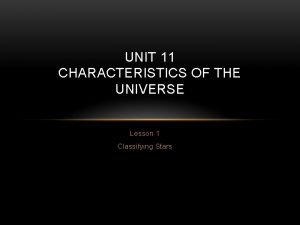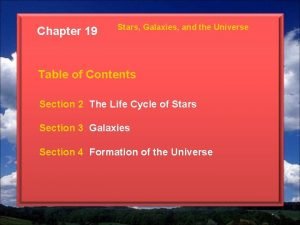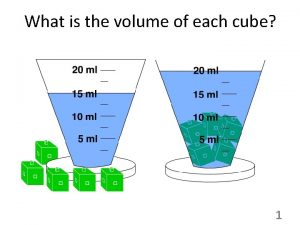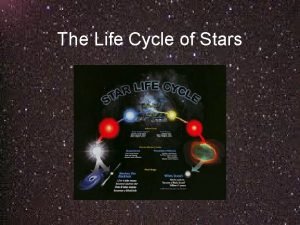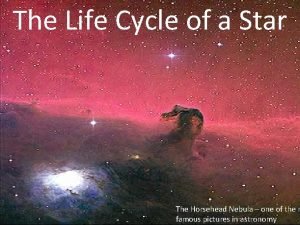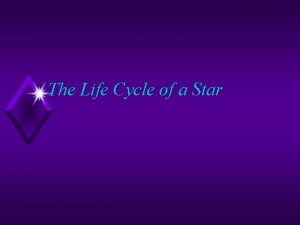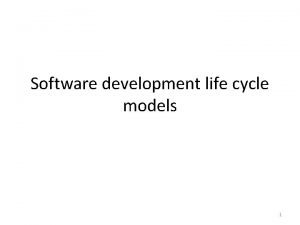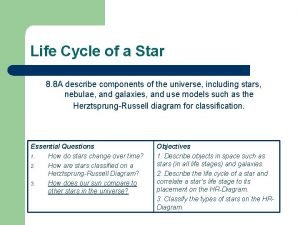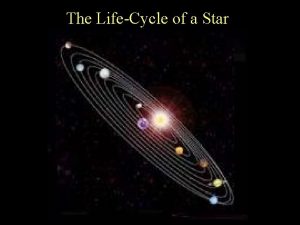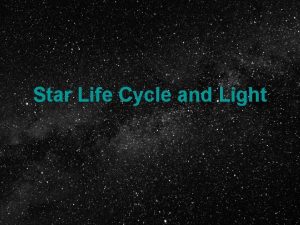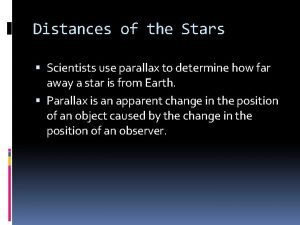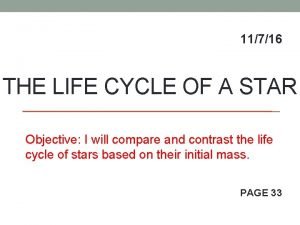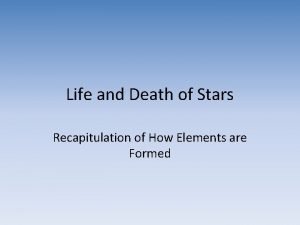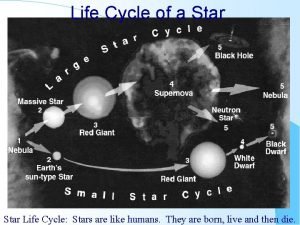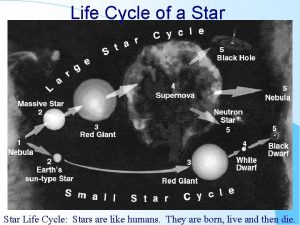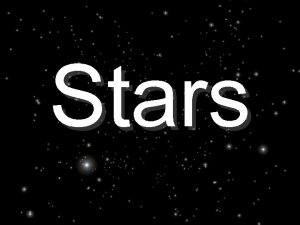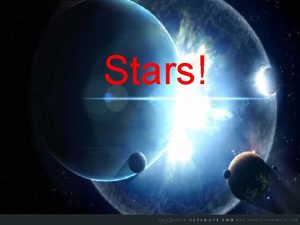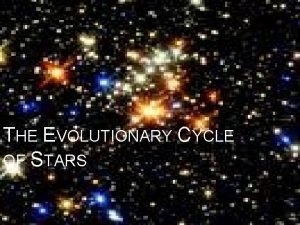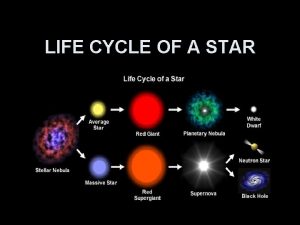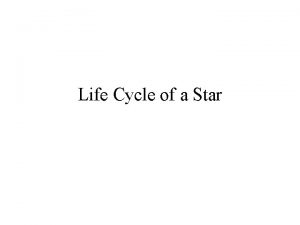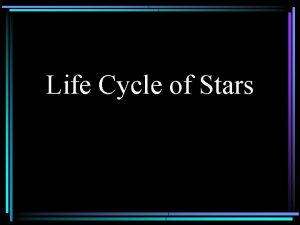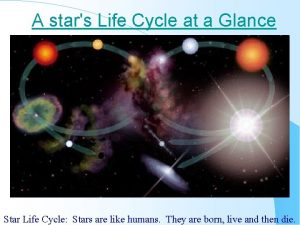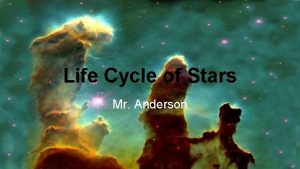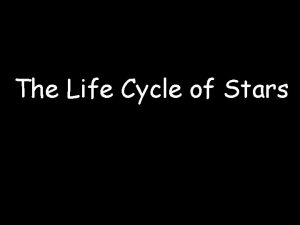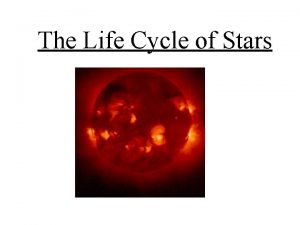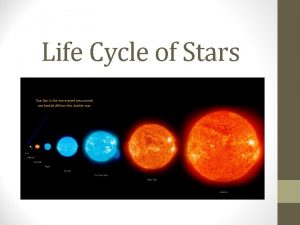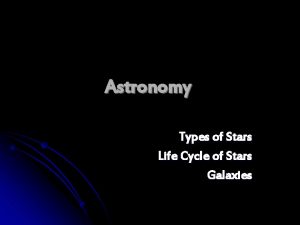STARS Life Cycle of A Star 1 Stars

























- Slides: 25

STARS

Life Cycle of A Star 1. Stars begin their lives as clouds of dust and gas called a stellar nebula.

How A Protostar Is Formed The gravity of a passing star or the shock wave from a nearby supernova may cause the nebula to contract. 1. Matter in the gas cloud will begin to come together into a dense region called a protostar. 2. As the protostar continues to condense, it heats up. 3. Eventually, it reaches a critical mass and nuclear fusion begins. 4. This begins the main sequence phase of the star. Our Sun is a main sequence star.

PROTOSTAR

Main Sequence Stars 1. The life span of a star depends on its size. 2. Very massive stars will become blue giants during their main sequence. Their main sequence may last only a few hundred thousand years. 3. Smaller stars, like the Sun, will burn for several billion years during their main sequence stage. 4. Our Sun is in its main sequence.

Main Sequence n After a star forms, it enters its 2 nd & longest part of its life— main sequence n Hydrogen fuses together to make helium, releasing large amounts of energy—much in the form of heat & light. n Stars that lose their gas slowly stay on the main sequence a long time. n Stars that lose their gas quickly stay on the main sequence a short time.

The main sequence is the longest part of a star’s life Average sized star like our Sun during main sequence. Massive star larger than our Sun during main sequence

3 rd stage of a star’s life = red giant n Goes to this after leaving the main sequence because it has used most of its hydrogen n The star continues to cool after leaving the main sequence, forming a red giant (10 X sun) or red supergiant (10 to 100 X the sun)

Red Giant and Red Supergiant 1. Eventually, the star's fuel will begin to run out. 2. Our Sun will expand into what is known as a red giant. 3. Massive stars will become red supergiants. 4. This phase will last until the star exhausts its remaining fuel. 5. At this point, the star will collapse.


Planetary Nebula Most average stars will blow away their outer atmospheres to form a planetary nebula. Shells of gas thrown out by some stars near the end of their lives

Planetary Nebula

White Dwarfs n Final stage of a star’s life cycle n Small, hot star made from the leftover core of a star n Can shine for billions of years before cooling completely

White Dwarf n Their cores will remain behind and burn as a white dwarf until they cool down. n From a planetary nebula an average star will become one of these, radiating into space

When Average Stars die n Average stars becomes red giants & then white dwarfs (stars like our sun)

White Dwarf

Dark Dwarf What will be left is a dark ball of matter known as a black dwarf. The last phase of an average star’s life

Life Cycle of our Sun 1. 2. 3. 4. 5. 6. 7. Stellar Nebula Protostar Main Sequence Red Giant Planetary Nebula White Dwarf Black Dwarf

Massive Stars 1. If the star is massive enough, the collapse will trigger a violent explosion known as a supernova. 2. If the remaining mass of the star is about 1. 4 times that of our Sun, it will collapse further to become a neutron star. 3. If the remaining mass of the star is more than about three times that of the Sun, it will collapse and what is left behind is an intense region of gravity called a black hole.

Massive Stars (Larger than our Sun) Become Red Supergiants.

Red Supergiant becomes Supernova in a giant explosion,

OR It becomes a Black Hole This is an illustration, not an actual black hole!!

Supernova Becomes a Neutron Star

Life Cycle of a Massive Star Stellar Nebula 2. Protostar 3. Blue Giant 4. Red Supergiant 5. Supernova 6. Neutron Star (Pulsar) OR 7. Black Hole 1.

Interactive Website • http: //aspire. cosmicray. org/labs/star_life/starlife_main. html
 Myrrh is mine its bitter perfume
Myrrh is mine its bitter perfume Life cycle of small stars
Life cycle of small stars Life cycle of a star notes
Life cycle of a star notes H
H Life cycle of stars graphic organizer
Life cycle of stars graphic organizer Chapter 19 section 2 the life cycle of stars answer key
Chapter 19 section 2 the life cycle of stars answer key Star life cycle 1-10
Star life cycle 1-10 Which layer
Which layer What is charted on an hr diagram?
What is charted on an hr diagram? Life cycle of a star
Life cycle of a star Life cycle of a star
Life cycle of a star Disadvantages of spiral model
Disadvantages of spiral model High mass star life cycle
High mass star life cycle Star life cycle model
Star life cycle model Star life cycle project
Star life cycle project Life cycle of an average star
Life cycle of an average star Star life cycle from birth to death
Star life cycle from birth to death The life cycle of a star nebular hypothesis
The life cycle of a star nebular hypothesis Beetlejuice planet size
Beetlejuice planet size Star life cycle from birth to death
Star life cycle from birth to death Life cycle of a star video
Life cycle of a star video Subgiant star life cycle
Subgiant star life cycle Life cycle of a star
Life cycle of a star Hci in software process
Hci in software process Life cycle of a star
Life cycle of a star Star life cycle
Star life cycle




